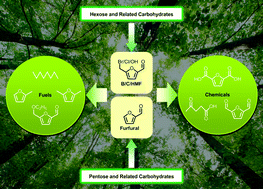Catalytic conversion of biomass-derived carbohydrates into fuels and chemicals via furanic aldehydes
Abstract
In recent years, substantial interest has been devoted to the conversion of biomass-derived

* Corresponding authors
a
School of Energy Research, Xiamen University, Xiamen, China
E-mail:
lulin@xmu.edu.cn
Fax: +86-0592-5952786
Tel: +86-0592-5952786
b Department of Paper and Bioprocess Engineering, State University of New York, College of Environmental Science and Forestry, Syracuse, NY, USA
In recent years, substantial interest has been devoted to the conversion of biomass-derived

 Please wait while we load your content...
Something went wrong. Try again?
Please wait while we load your content...
Something went wrong. Try again?
L. Hu, G. Zhao, W. Hao, X. Tang, Y. Sun, L. Lin and S. Liu, RSC Adv., 2012, 2, 11184 DOI: 10.1039/C2RA21811A
To request permission to reproduce material from this article, please go to the Copyright Clearance Center request page.
If you are an author contributing to an RSC publication, you do not need to request permission provided correct acknowledgement is given.
If you are the author of this article, you do not need to request permission to reproduce figures and diagrams provided correct acknowledgement is given. If you want to reproduce the whole article in a third-party publication (excluding your thesis/dissertation for which permission is not required) please go to the Copyright Clearance Center request page.
Read more about how to correctly acknowledge RSC content.
 Fetching data from CrossRef.
Fetching data from CrossRef.
This may take some time to load.
Loading related content
